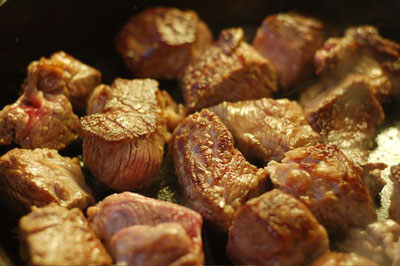
Use a heavy pan with a very tight-fitting lid. When browning the meat, don't salt in advance or there will be excess moisture, which leads to steaming. Some cooks don't salt at all before browning stew meat. Likewise, avoid crowding the pan. It's worth it, for flavor, to brown in two or three batches. If all those chunks of meat are touching each other, you've put in too many. Wait until the meat releases itself from the bottom of the pan -- if it's still gripping, it's not ready to be turned yet. Aim for nice, deep brown edges in order to establish a meaty base for your stew.
If I'm feeling happy, I might flame off the meat with some cognac. If I'm in a rush, I skip this.
Remove the meat to a plate, spoon out excess fat or add extra fat as needed. (Tri-tip won't give off much at all, so I keep a jar of duck fat in my freezer for emergencies like this.) Then, continue with the vegetables.
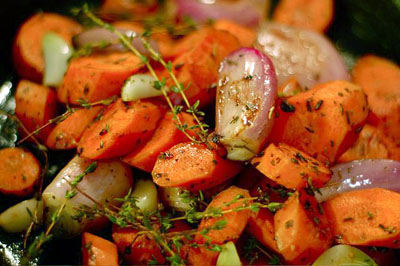
For long-cooked stews, keep your vegetables in big pieces. For this version, I used whole shallots and some whole garlic cloves. Some people like to cook them separately and add later, perhaps stirring them in just before serving. I've never liked this because the flavors are never deep enough for me. I'm willing to sacrifice some carrot color for carrot complexity. Lots of fresh thyme, a sprinkle of herbes en Provence, a few strips of orange zest and a couple of bay leaves round out the mirepoix.
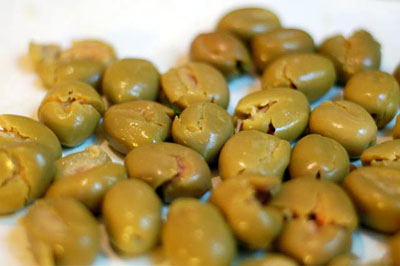
Green olives from the south of France, say picholine, would be appropriate, but those big Greek ones are fine, too. I keep meaning to try the pitted ones stuffed with almonds or garlic, but being rather conservative with comforting food like this, I have stuck with plain olives. I do think the pimento-stuffed ones would look silly.
Old recipes call for a handful. I love olives, so my own recipe calls for two big fistfuls.
If they still have their pits, spread them in a single layer on your cutting board and crush them gently with the bottom of a saucepan. Then pop out their pits. You can be a heartless, lazy host and leave in the pits. Just be sure to warn your guests!
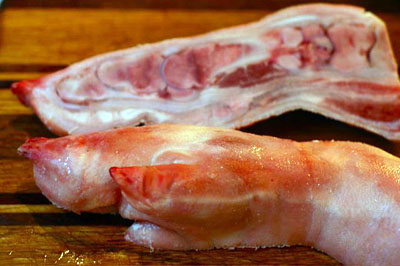
My own not-so-secret technique for adding body, especially with flavorful but lean cuts such as tri-tip, is to pour in a full bottle of wine (minus one glass for the cook, of course) and then toss in a pig's foot. Ask the butcher to cut it in half lengthwise. And if you're wondering where the heck you find a pig's foot, head to the nearest market frequented by Asian, Latino or African-American cooks. I usually remove the foot before serving, snacking on its winey goodness by myself while standing in the kitchen.
If you prefer, you can use a thick piece of fatback, which you can find at most supermarkets.
Or, to avoid pork entirely, you can make a thick paste of equal amounts butter and flour, a.k.a beurre manier, to stir into the stew 15 minutes before serving.
Or, you can just enjoy your stew on the thinner, healthier side.
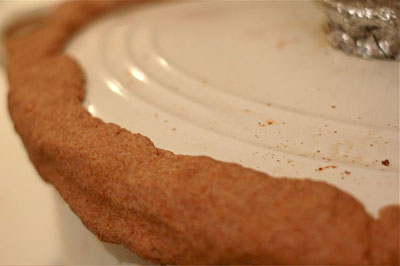
Before my pan goes into the oven, I seal it with a long, thick rope rolled out from a firm dough of just flour and water. You could try using foil beneath the lid for an extra layer of moisture barrier instead. I once thought all this merely frivolous -- until I gently cooked away all the liquid of one of my stews and had to start over with a cobbled together sauce half an hour before the guests arrived.
If you're taking the stew to a potluck, keep the lid sealed on it. If you have a heavy cast-iron pot and wrap it in a thick towel, it'll stay warm for a good hour. I like to serve daube with wide, parsley egg noodles or garlicky mashed potatoes, or lots and lots of crusty bread.
BEOUF EN DAUBE
To make a dough for sealing the lid, stir a small amount of tepid water into about 3 cups of flour to form a stiff dough. Knead briefly, then roll into a long, thick rope; cover and set aside until needed.
Makes: 12 servings
Ingredients:
3 tablespoons olive oil
3 pounds beef roast, such as tri-tip, cut into large cubes
1 large carrot, cut into thick rounds
8 shallots, peeled
8 cloves garlic, peeled
Small bunch of fresh thyme
1 teaspoons herbes de Provence
4 wide strips of orange zest
2 bay leaves
1 bottle of dry red wine
2 to 4 cups good-quality beef or chicken stock
1 1/2 to 2 cups green olives, pitted
1 pig's foot, halved lengthwise and soaked in boiling water for 5 minutes
Salt and black pepper
Chopped flat-leaf parsley
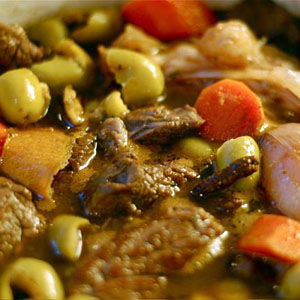 As a member of a recently formed meat club, one that divides up monthly deliveries from Marin Sun Farms, I have been revisiting some of my favorite beef, lamb and goat recipes. After a few years of rarely cooking big pieces of meat in my kitchen (the meat lover in my heart is always duking it out with the vegetarian of my brain), I had a large roast in the freezer that required some attention.
As a member of a recently formed meat club, one that divides up monthly deliveries from Marin Sun Farms, I have been revisiting some of my favorite beef, lamb and goat recipes. After a few years of rarely cooking big pieces of meat in my kitchen (the meat lover in my heart is always duking it out with the vegetarian of my brain), I had a large roast in the freezer that required some attention.



